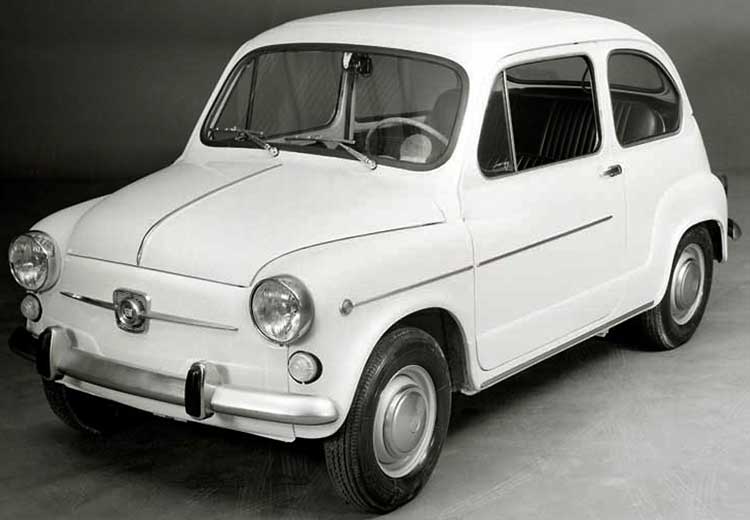
Your support helps us to tell the story
From reproductive rights to climate change to Big Tech, The Independent is on the ground when the story is developing. Whether it's investigating the financials of Elon Musk's pro-Trump PAC or producing our latest documentary, 'The A Word', which shines a light on the American women fighting for reproductive rights, we know how important it is to parse out the facts from the messaging.
At such a critical moment in US history, we need reporters on the ground. Your donation allows us to keep sending journalists to speak to both sides of the story.
The Independent is trusted by Americans across the entire political spectrum. And unlike many other quality news outlets, we choose not to lock Americans out of our reporting and analysis with paywalls. We believe quality journalism should be available to everyone, paid for by those who can afford it.
Your support makes all the difference.So, Fiat's new 500 is Car of the Year, 50 years after the car whose shape it reprises was itself revealed. That original 500, the tiny rear-engined one whose engine really was of approximately 500cc, appeared in 1957. But it wasn't the only rear-engined, Fiat-type car launched that year.
Spain, too, has cause to celebrate a half-century of mass mobility. The Seat 600, launched in 1957 as a licence-built version of the Fiat 600 which was itself revealed in 1955, became Spain's most popular car right up to the end of production in 1973. It outlasted the Italian version, replaced by the 600-derived Fiat 850, by nearly a decade.
We never saw the Seat 600 here in the UK, and even those few Seat-built Fiats which later came here always wore Fiat badges. Nor were Italian Fiats seen in Seat's homeland, because Franco's Spain was a closed country in which car imports were prohibitively expensive and far beyond most people's means. But the Seat 600 completely changed the Spanish roadscape, and research by today's Seat company shows that even as late as 1971, one in four cars on Spanish roads was a 600.
Not surprisingly, the Seat 600 became a national insititution and a symbol of Spain's transition into the modern world. Its nicknames included Seilla o garbancito or "chickpea" and Ombligo or "belly button", the latter because it seemed everyone had one. It figured in folksongs and films, and writer Manuel Vazquez Montalban, a keen observer of Spain's reinvention, wrote that "The day Spaniards got into their 600s, they began to leave their past behind them, embarking on a weekend trip from which they have not yet returned."
After the Second World War, and still socially fractured from its earlier civil war, Spain was far behind the rest of western Europe in terms of mass road transport. Under Franco's policies the only way cars were going to be available to the mass market was if they were built in Spain, and so it was that Spain's first mass-market carmaker set up shop in Barcelona with considerable help from Fiat. The Sociedad Espanola de Automoviles de Turismo, or Seat, was duly created, its name rather similar in sense to the components of Fiat's acronym, Fabbrica Italiana Automobili Torino.
Seat began operations in 1950 with its version of the Fiat 1400. Renault, Peugeot and Citroë* would join in with Spanish factories in later years, as would our own British Motor Corporation with its Authi brand. (Among other things Authi made versions of the BMC 1100 with extended boots, and in a feat of transnationalism it built Spanish versions of Italy's upmarket Innocenti Minis.)
But Seat was the dominant force, and the 600 was the breakthrough car, rendering the country's microcars, sidecar-equipped motorcycles and three-wheeled vans obsolete.
The Italian original was Fiat's first rear-engined car and spawned, in 1956, the first compact MPV the six-seat Multipla. The Multipla didn't make the move to Seat, but the Spanish company created its own four-door 600 derivative in 1963 called the 800. The name reflected a rise in engine size from 633 to 767cc, also applied to the 600, now known as the 600D.
Spanish versions of non-Spanish cars had differing configurations of doors and boots. Later, Seat made the 147, a four-door Fiat 127. It concluded the 600 story with its own-design Seat 133, a squared-off, updated 850 which represented the final evolution of the 600 line of water-cooled, four-cylinder, rear-engined Fiats.
Fiat sold right-hand drive Seat 133s in the UK with Fiat badges, as it had sold Seat-built, Fiat-badged 850Ds before, alongside new-fangled, front-wheel drive 127s in the early 1970s, but Fiat in Italy regarded the 133 as outside the family. In the definitive book All the Fiats, my edition of which chronicles every Fiat model from 1899 to 1999, the 133 is mysteriously absent.
The final Seat 600, an "L Especial" in white, left the assembly line on 3 August 1973 amid much fond press coverage. Around 800,000 had been built, about 10 per cent exported, typically to Latin America. Seat, however, was not the only licensee of the Fiat 600. Zastava in Yugoslavia played out a similar story, and today you'll more Zastava 600s and 750s in the Balkans than Seat 600s in Spain. And these are cars that have lived through a civil war rather than the aftermath of one.
But Spain still loves its Seat 600. There was a huge display of them at the Barcelona classic car show last year, some race-tuned, some customised, some wearing coachbuilt bodies. What chance, then, of a new, retro-styled Seat 600? I can't see either VW-controlled Seat or Fiat going for that idea. Pity; the Spaniards would love it.
Everyone had one, so they called it 'belly button'.
Join our commenting forum
Join thought-provoking conversations, follow other Independent readers and see their replies
Comments